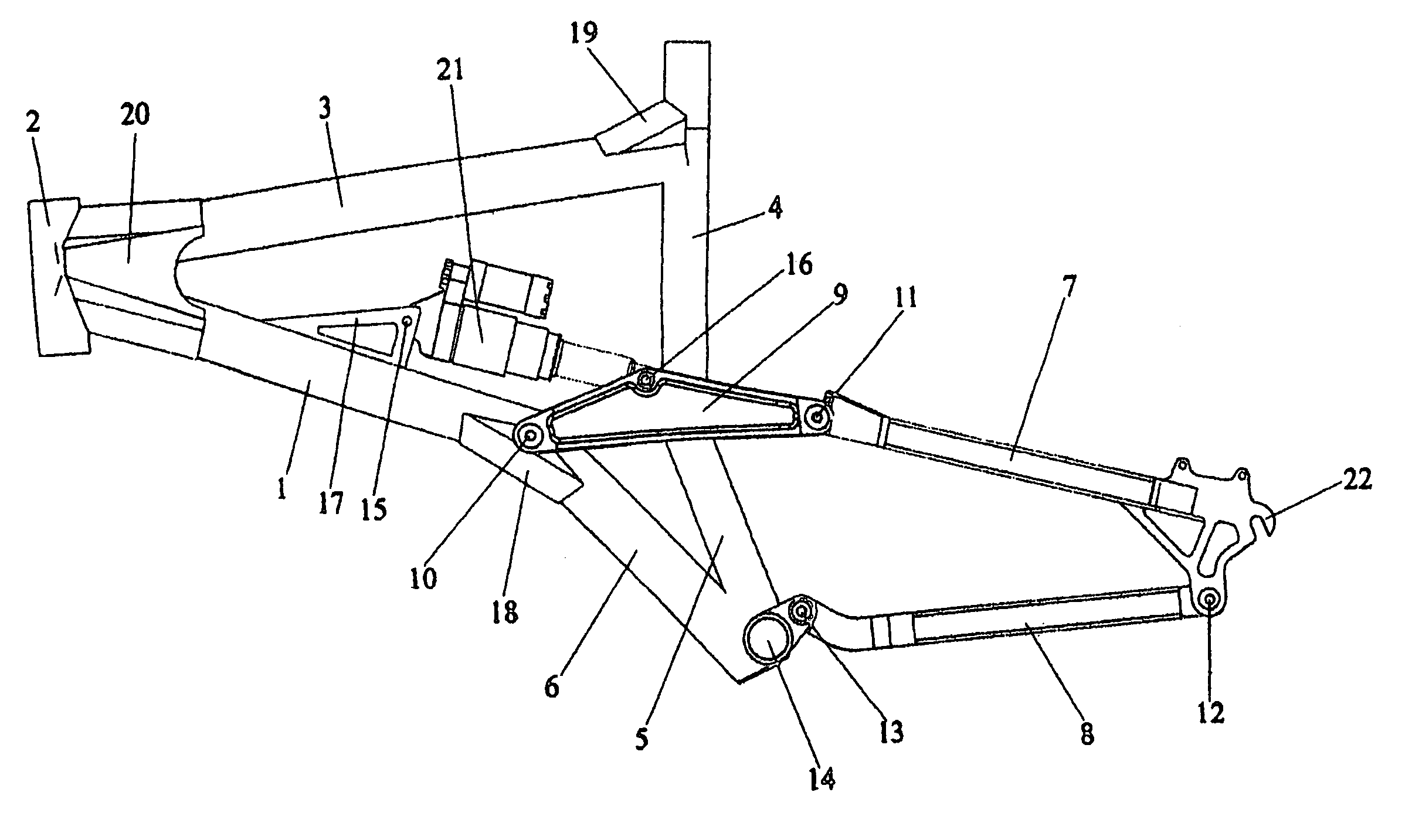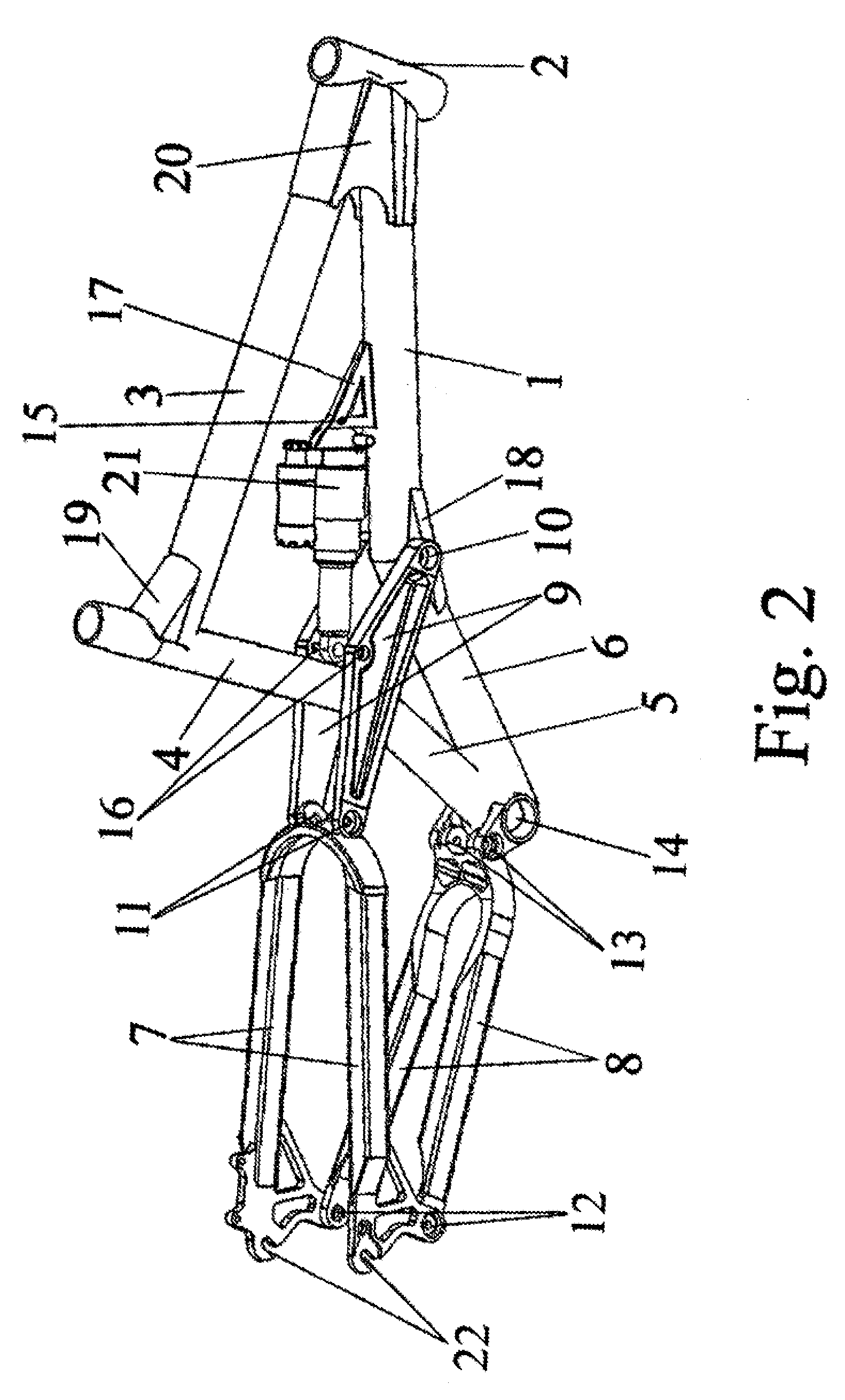“n simple swingarm rear suspension, the swing arms pivot sharply upward when a surge of power is supplied to the rear wheel, and pivot downward again when the power is backed off.” When a mountain bike is ridden over rough terrain, this “jacking” can reduce the contact of the rear wheel with the riding surface, which can severely compromise the rider's control over the bike.
“Jacking further reduces performance because the upward movement of the rear wheel results in a dissipation of power that might otherwise go to forward propulsion of the bike.
Such losses may be of little consequence for a motorcycle, but are intolerable to a bicyclist seeking peak performance.” Id.
However, in U.S. Pat. No. 6,926,298, Anthony Ellsworth argued that “horst link” style bikes fail to cancel pedal induced and suspension induced forces directly, thereby resulting in shock binding and decreased suspension activity.
The seat tube is not only a weaker structural member of the bike, but it limits the length of the bicycle's rear suspension components.
Since the rear suspension is usually made up of upper arm members and another device (such as Specialized's links, or Ellsworth's rocker arms), attaching these links, rocker arms, or torque conversion devices onto the seat tube directly effectively limits the length of the rear suspension, compromising the suspension's ability to maintain traction and track terrain under extreme or fast riding situations.
At high speeds, where small forces imparted on to the bike are magnified, such a configuration could only result in
instability.
The only way to remedy such a situation would be to add additional weight to the bike in the form of thicker, thus stronger, material to counteract the magnified forces, thereby reducing rider performance because of the additional energy required to travel the same distance with a heavier bicycle.
Additionally, in these prior designs, forces are imparted onto the seat tube (or any other area of the main frame that are not properly aligned with the angle of a key structural member of the frame), which create forces on the bike that work against the forward propulsion induced by pedaling.
Thus the advances of previous designs are eclipsed and have become outdated.
If the forces are not aligned with a structural member of the frame, the rear wheel would be driven upwards, compressing the
shock absorber, and thus reducing its ability to absorb
impact from the terrain-decreasing the performance of the bike.
Unfortunately Specialized chose to incorporate different shocks (Produced by RST and Fox) rather than utilizing something produced by Amp-Research (Amp did make shocks and rear suspension parts for other companies such as Fat Chance and Dagger).
The shocks utilized lacked the stable pedal damping characteristics, which were later developed.
The most inefficient designs use manual-lockouts on the shocks themselves.
The irony is, while FSR's were complimented for being able to respond to relatively small forces notably well, Amp designs were criticized for failing to respond to those same small forces—because the stable pedal compression damping circuit they used isolated small movements (i.e. small bumps).
Amp also had a
titanium spring option for their shock absorbers, which removed nearly a pound from the coil-sprung weights, though it incurred an additional expense.
As previously mentioned these advances outdated prior art designs intending to reduce pedal bob.
All of these designs heretofore known suffer from a number of disadvantages:(a) Both “horst link” and FSR designs require more intensive manufacturing to work around an uninterrupted seat tube and seat mast to
mount a shock-activating link on the seat tube.
Thereby increasing the time needed to manufacture and assemble the components of the frame.
This increases the cost of manufacturing and decreases the efficiency of workers and use of materials resulting in products that are less capable of bearing profit.(b) FSR designs utilize a link system, which is innately defective; it is not engineered to be a structurally significant member of the frame thus creating a weak element.
The stresses applied to this component fail to make use of the tinsel strength of the
metal (greatest) instead relying on its inferior rigidity and ability to
resist bending.
Because of its relatively thin composition it is cursed by a weak nature and is prone to fatigue resulting in the failure of the frame.(c) Prior art provides no support conduit for the forces impounded by the rider and the ground to be completely channeled into a
load bearing structure.
This requires an excessive amount of material to be utilized in the frame.
Thus the weight of the frame is increased, as well as the material and manufacturing cost.(d) Use of a gusseted downtube to facilitate the properties of force channeling is absent from prior art.
No prior art uses a gusseted downtube to reduce the need for bracing, thus requiring that extra bracing be integrated into the frame design.
Incurring additional weight, material and manufacturing costs.(e) All prior art designs suffer from extraneous movement thus inducing fatigue of components reducing their integrity.
The prior art designs fail to counter these forces thus allowing them to affect the performance of both user and frame.
This unsatisfactory performance decreases the desirability of such frames to the
consumer market.(f) Placement of the pivot point in prior art is such that it is not capable of bearing significant loads creating a weak element in the frame design.
Though varied in position, all prior art neglects the ability of a frame to channel forces and thereby incur extra weight in their designs and the aforementioned disadvantages.
 Login to View More
Login to View More  Login to View More
Login to View More 


